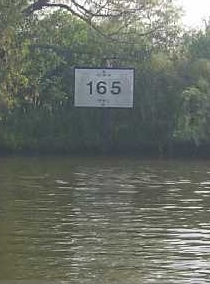Gulf Intracoastal Waterway
The waterway provides a channel with a controlling depth of 12 ft (3.7 m), designed primarily for barge transportation. Although the U.S. government proposals for such a waterway were made in the early 19th century, the Gulf Intracoastal Waterway was not completed until 1949.
EHL & WHL mileages

Locations along the Gulf Intracoastal Waterway are defined in terms of statute miles (as opposed to nautical miles, in which most marine routes are measured) east and west of Harvey Lock, a navigation lock in the New Orleans area located at 29°54′32″N 90°05′02″W / 29.909°N 90.084°W. The Hathaway Bridge in Panama City, Florida, for example, is at mile 284.6 EHL (East of Harvey Lock). The Queen Isabella Causeway Bridge at South Padre Island is at mile 665.1 WHL (West of Harvey Lock).
Connecting waterways
The Gulf Intracoastal Waterway crosses or meets, and in some cases is confluent with, numerous other navigable rivers and waterways. They include:
- Apalachicola River
- Arroyo Colorado
- Atchafalaya River
- Bayou Lafourche
- Bayou Terrebonne
- Calcasieu River
- Calcasieu Ship Channel
- Delcambre Canal
- Houston Ship Channel
- Industrial Canal
- Lower Mississippi River
- Mississippi River-Gulf Outlet Canal
- Mobile Bay (connecting to the Tenn-Tom Waterway)
- Pearl River
- Sabine-Neches Waterway (Includes portions of)
- Santa Rosa Sound
- The Rigolets
- Vermilion River
Ports and harbors

Many of the busiest ports in the United States in terms of tons of cargo are located on or near the Gulf Intracoastal Waterway. Notable ports on or near the waterway include:
Florida
Alabama
- Mobile, Alabama - Ranked 11th busiest
Mississippi
- Gulfport, Mississippi
- Pascagoula, Mississippi - Ranked 29th busiest
Louisiana
- Baton Rouge, Louisiana - Ranked 7th busiest
- Houma, Louisiana -
- Intracoastal City, Louisiana
- Lake Charles, Louisiana - As of mid-2024 ranked 10th busiest. The GIWW has the Calcasieu Lock just east of Lake Charles. The three-fold purpose is to facilitate navigation, provide flood relief, and prevent possible saltwater intrusion into the Mermentau River Basin.
- Larose, Louisiana
- Morgan City, Louisiana
- New Orleans, Louisiana - Ranked 5th busiest
- Port Allen, Louisiana
- Port of South Louisiana - Ranked 2nd busiest
- Port of Plaquemines - Ranked 12th busiest
Texas
- Beaumont, Texas - Ranked 8th busiest
- Brownsville, Texas
- Corpus Christi, Texas - Ranked 3rd busiest
- Port Freeport, Texas - Ranked 16th busiest
- Galveston, Texas - Ranked 46th busiest
- Houston, Texas - Ranked as busiest port in the United States
- Port Arthur, Texas - Ranked 15th busiest
- Port Lavaca - Point Comfort, Texas
- Texas City, Texas - Ranked 20th busiest
- Victoria, Texas
See also
References
- ^ Transportation Research Board 2004, p. 30.
- ^ US Army 2013.
- ^ Leatherwood, Art (15 June 2010). "Gulf Intracoastal Waterway". Handbook of Texas Online. Texas State Historical Association. Retrieved March 23, 2020.
- ^ Lynn M. Alperin. "History of the Gulf Intracoastal Waterway" (PDF). U.S. Army Corps of Engineers Office of History. Archived from the original (PDF) on 2005-12-08. Retrieved 2006-04-03.
- ^ "33 CFR 89.25 Waters Specified by the Secretary" (PDF). U.S. Coast Guard Navigation Center. Retrieved 2006-04-21.
- ^ "Tonnage of Top 50 U.S. Water Ports, Ranked by Total Tons". U.S. Bureau of Transportation Statistics. Retrieved 2022-10-14.
- ^ "Calcasieu Lock Navigation Study, Louisiana: Calcasieu Lock Diversion Channel Ship Simulation Report". Defense Technical Information Center. Retrieved 2024-07-23.
Sources
- The Marine Transportation System and the Federal Role: Measuring Performance, Targeting Improvement. Special report (National Research Council (U.S.). Transportation Research Board). Transportation Research Board. 2004. ISBN 978-0-309-09452-8. Retrieved 2023-06-03.
- US Army (March 6, 2013). "What is the district's role in maintaining the GIWW?". army.mil. US Army.